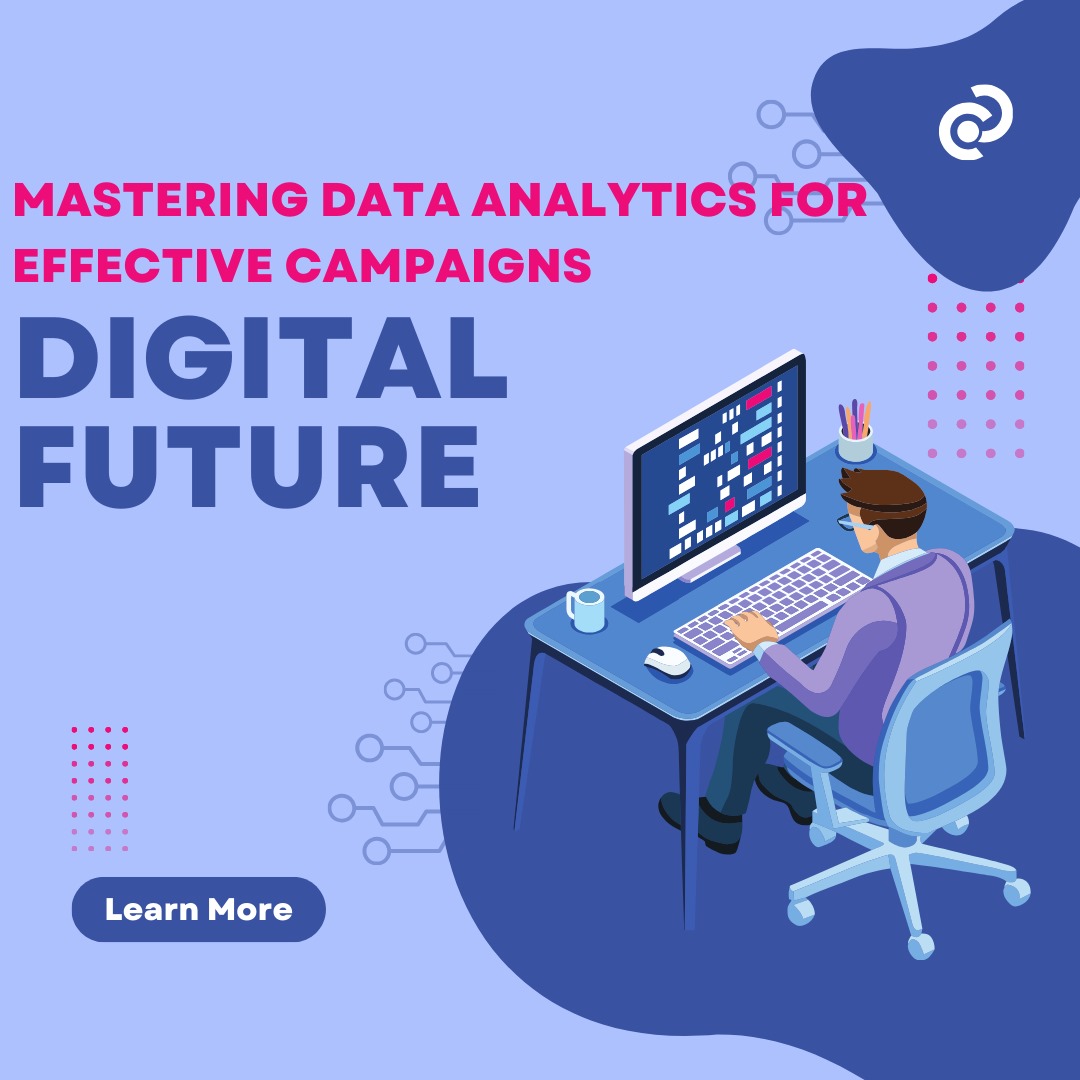In today’s digital marketing landscape, data analytics has become the cornerstone of success. Brands that embrace data-driven decision-making can achieve more precise targeting, improve campaign performance, and optimize future marketing strategies. By analyzing consumer behavior, tracking key performance indicators (KPIs), and applying insights to refine campaigns, businesses can gain a competitive edge and enhance their marketing ROI. This article explores how data analytics is reshaping digital marketing, the tools and techniques used to analyze consumer behavior, track campaign performance, and optimize future marketing efforts.
The Shift to Data-Driven Decision Making
Traditional marketing relied on intuition, experience, and broad demographic data to guide decision-making. However, the advent of digital marketing has dramatically shifted this dynamic. Now, businesses have access to vast amounts of data that provide deep insights into customer behavior, campaign performance, and the overall market landscape. By leveraging data analytics, digital marketers can make informed, evidence-based decisions, ensuring their efforts are more focused, targeted, and effective.
Data-driven decision-making allows marketers to:
- Better Understand Customer Behavior: With advanced analytics tools, businesses can track how customers interact with their websites, social media platforms, and emails. This understanding helps in tailoring messages and offers that resonate with their audience, leading to higher engagement and conversions.
- Personalize Campaigns: Data analytics enables the segmentation of audiences based on their preferences, purchase history, and behavior. Marketers can create personalized campaigns that cater to the specific needs of each segment, enhancing customer satisfaction and loyalty.
- Optimize Marketing Spend: Rather than allocating marketing budgets to broad, general strategies, data-driven insights help businesses identify which channels, campaigns, and tactics are yielding the best results. This allows for better budget allocation and maximizes ROI.
- Improve Campaign Effectiveness: With access to real-time data, digital marketers can quickly assess the performance of their campaigns, make adjustments on the fly, and experiment with new strategies to improve outcomes.
Tools for Analyzing Consumer Behavior
To effectively track and analyze consumer behavior, marketers use a variety of tools that offer insights into how users interact with digital assets such as websites, social media, and email campaigns. Below are some key tools and techniques commonly used to analyze consumer behavior:
1. Google Analytics
Google Analytics is one of the most widely used and comprehensive tools for tracking website performance. It allows marketers to monitor various metrics, such as:
- Traffic Sources: Understand where your website traffic is coming from (organic search, paid ads, social media, etc.), allowing you to focus efforts on the most effective channels.
- User Behavior: Track how visitors navigate through your site, what pages they visit, how long they stay, and where they drop off. This can help identify pain points in the user journey and optimize the website for better engagement and conversions.
- Conversion Tracking: Set up conversion goals to track key actions, such as form submissions, product purchases, or email sign-ups. This helps assess the success of campaigns and identify areas for improvement.
2. Customer Relationship Management (CRM) Systems
CRM tools like Salesforce, HubSpot, and Zoho help businesses gather and store data on customer interactions across multiple touchpoints. These systems enable marketers to track:
- Customer Lifecycle: Monitor how customers move through the sales funnel—from awareness to consideration to purchase—and identify opportunities to nurture relationships.
- Segmentation: CRMs allow businesses to segment customers based on behaviors, preferences, and demographics. This segmentation helps tailor marketing messages and campaigns to different customer groups.
- Lead Scoring: Marketers can use CRM data to assign lead scores based on customer interactions, enabling them to prioritize leads who are more likely to convert.
3. Social Media Analytics Tools
Social media platforms such as Facebook, Instagram, Twitter, and LinkedIn provide built-in analytics tools to measure engagement and track the success of social campaigns. Additionally, third-party tools like Hootsuite, Sprout Social, and Buffer can offer deeper insights, such as:
- Engagement Metrics: Track likes, shares, comments, and click-through rates to understand which posts resonate with your audience and drive interactions.
- Audience Insights: Social platforms provide demographic and interest-based data, helping businesses understand the makeup of their audience and create more targeted content.
- Sentiment Analysis: Tools that analyze social media mentions can help businesses gauge public sentiment about their brand, products, or services, providing valuable feedback for campaign adjustments.
4. Heatmaps and Session Recordings
Heatmap tools like Hotjar and Crazy Egg provide visual representations of how users interact with web pages. Heatmaps show where users click, how far they scroll, and what elements of the page attract the most attention. This data can help businesses:
- Optimize Website Layout: Identify sections of a webpage that users frequently ignore and adjust the layout or design to improve user experience.
- Improve Calls-to-Action (CTAs): Evaluate how effective your CTAs are by analyzing their placement and performance. This allows marketers to optimize CTA buttons for maximum visibility and conversion.
5. A/B Testing Tools
A/B testing tools like Optimizely and Unbounce allow marketers to test different versions of web pages, ads, or email campaigns to see which performs better. By testing elements such as headlines, images, color schemes, and CTAs, businesses can:
- Optimize Conversions: A/B testing helps identify which variations lead to higher conversion rates, allowing marketers to refine campaigns for better results.
- Validate Hypotheses: Marketers can test assumptions about what will resonate with their audience and use real data to confirm or refute their ideas.
Techniques for Tracking Campaign Performance
Tracking campaign performance is a crucial component of any digital marketing strategy. By monitoring key metrics, marketers can understand how well their campaigns are performing and make adjustments as needed. Some common techniques for tracking campaign performance include:
1. Key Performance Indicators (KPIs)
KPIs are metrics that help businesses evaluate the success of their campaigns and determine if they are achieving their goals. Common KPIs for digital marketing campaigns include:
- Traffic Metrics: Website visitors, page views, and bounce rates.
- Engagement Metrics: Likes, shares, comments, and social media interactions.
- Conversion Metrics: Conversion rate, cost per conversion, and customer acquisition cost (CAC).
- Revenue Metrics: Return on investment (ROI), average order value (AOV), and lifetime value (LTV).
2. Attribution Models
Attribution models help marketers determine which touchpoints in the customer journey are most responsible for driving conversions. Common attribution models include:
- Last-click Attribution: Attributes the conversion to the last touchpoint before the purchase.
- First-click Attribution: Attributes the conversion to the first touchpoint in the customer journey.
- Linear Attribution: Distributes credit evenly across all touchpoints in the customer journey.
- Time Decay Attribution: Gives more credit to touchpoints closer to the conversion.
Choosing the right attribution model helps marketers allocate resources effectively and understand the true impact of each marketing channel.
Optimizing Future Efforts Using Data
Once data has been collected and analyzed, businesses can apply the insights to optimize future marketing campaigns. Data analytics enables continuous improvement through the following methods:
- Identify Trends and Patterns: By analyzing data over time, businesses can identify emerging trends and patterns in customer behavior, allowing them to predict future behavior and stay ahead of the competition.
- Personalization: Data allows businesses to create highly personalized campaigns tailored to individual customer preferences, improving engagement and conversion rates.
- Automate Campaigns: Automation tools like email marketing platforms (e.g., Mailchimp or Klaviyo) can trigger personalized messages based on customer behavior, ensuring timely and relevant communication.
- Real-Time Adjustments: With real-time data analysis, marketers can make adjustments to campaigns on the fly, ensuring that they are continually optimized for better performance.
Conclusion
Data analytics is reshaping the digital marketing landscape by empowering businesses to make data-driven decisions that enhance campaign performance and maximize ROI. By utilizing tools to analyze consumer behavior, track campaign performance, and optimize future marketing efforts, businesses can better understand their customers and craft more effective, targeted campaigns. As data analytics continues to evolve, companies that embrace this approach will be better equipped to adapt to changing market conditions and stay competitive in a fast-paced digital environment.




I love how this article highlights the central role of data analytics in modern digital marketing
. You clearly break down key areas—A/B testing, real-time performance tracking, customer segmentation, and predictive analytics—that help marketers fine-tune campaigns and maximize ROI.
we strongly believe that data analytics is the backbone of successful we strongly believe that data analytics is the backbone of successful digital marketing. By leveraging analytics, marketers can understand user behavior, track campaign performance in real time, and make data-driven decisions that maximize ROI.
Whether it’s A/B testing, customer segmentation, or predictive analysis—data empowers brands to personalize their strategies and stay competitive in today’s fast-evolving digital landscape.. By leveraging analytics, marketers can understand user behavior, track campaign performance in real time, and make data-driven decisions that maximize ROI.
Whether it’s A/B testing, customer segmentation, or predictive analysis—data empowers brands to personalize their strategies and stay competitive in today’s fast-evolving digital landscape.
Fantastic read! I love how this article highlights the central role of data analytics in modern digital marketing. You clearly break down key areas—A/B testing, real-time performance tracking, customer segmentation, and predictive analytics—that help marketers fine-tune campaigns and maximize ROI.